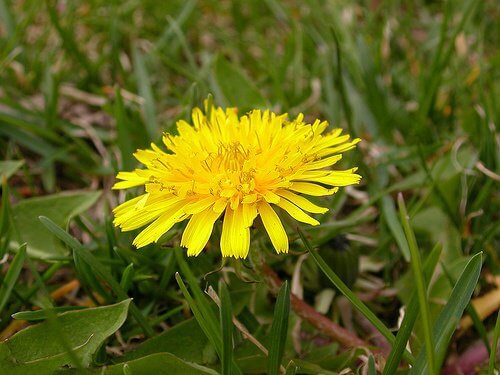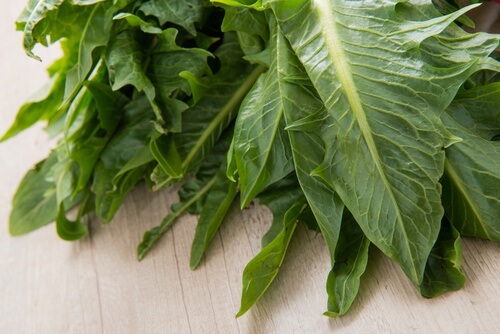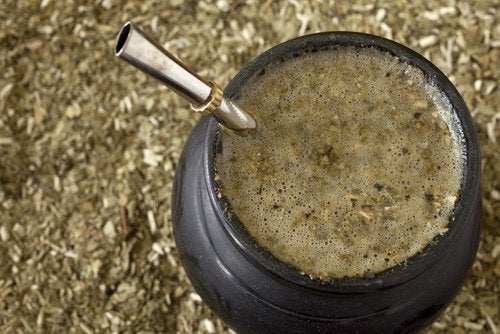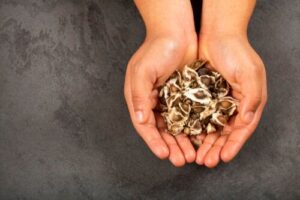체중 감량을 위해서는 건강하고 균형 잡힌 식단, 규칙적인 신체 운동, 충분한 물 섭취와 건강한 습관을 포함하는 포괄적인 계획을 따라야 한다. 이번 글에서는 체중 감량을 돕는 식물 11가지를 알아보자.
체중 감량을 돕는 식물 11가지
체중 감량을 돕는 식물은 크게 두 가지 효능으로 나눌 수 있다.
- 이뇨: 남아있는 체액을 제거하고 소변 생성을 증가한다.
- 해독: 이것은 신체의 전반적인 신진대사와 지방 연소 능력을 향상한다.
포괄적인 체중 감량 계획을 따르고 있다면 이 글에서 소개할 식물을 통해 단시간에 원하는 결과를 얻을 수 있다.
체중 감량을 위한 이뇨 및 정화 식물
다음은 이뇨 작용과 정화 효과가 있는 식물들이다.
쇠뜨기
쇠뜨기를 활용하는 방법은 다음과 같다.
재료
- 말린 쇠뜨기 100g
- 물 1리터
준비법
- 끓는 물에 쇠뜨기를 넣고 다시 30분 동안 끓인다.
- 그런 다음 불을 끄고 뚜껑을 덮은 상태에서 식힌다 .
- 찻물을 걸러내고 병이나 뚜껑이 있는 용기에 붓고 냉장고에 보관한다.
- 매일 물 한 컵(200mL)에 찻물을 2테이블스푼(15ml) 섞어서 마신다.
- 이 차는 2주 이상 보관하지 않는다.
더 읽어보기: 간 해독에 도움을 주는 5가지 식품
체중 감량을 돕는 식물: 민들레
민들레는 체중 감량뿐만 아니라 콜레스테롤 수치도 낮춘다. 민들레의 효능을 활용하려면 차로 만들어 마시자.
재료
- 말린 민들레 잎과 뿌리 1줌
- 물 1.5리터
준비법
- 물을 끓이고 민들레를 넣고 다시 15분간 끓인다.
- 열에서 제거하고 약간 식힌다.
- 그런 다음 민들레 잎을 걸러낸 다음 약간의 꿀을 넣어 달게 만든다.
- 식사 전에 이 차를 한 잔 마신다.
쐐기풀

이 식물에 관해 많은 오해가 있지만 체중 감량에 도움이 되는 유익한 특성이 많이 있다.
재료
- 말린 쐐기풀 잎 2테이블스푼(30g)
- 물 1리터
준비법
쐐기풀을 물에 10분 동안 끓인다. 차게 식힌 다음 찻물을 걸러서 식사 전 세 컵까지 마신다.
자작나무
자작나무 껍질은 건강상 이점 때문에 널리 사용된다.
재료
- 자작나무 껍질 50g
- 물 1리터
준비법
- 껍질을 5분 동안 끓인다.
- 그런 다음 불을 끄고 5분 더 우린다.
- 다른 용기에 담아서 보관한다.
물이나 천연 주스로 희석하여 하루에 최대 6테이블스푼을 마신다.
더 읽어보기: 살과 부기를 동시에 빼는 건강 스무디
체중 감량을 돕는 식물: 치커리 뿌리
치커리는 때때로 상추처럼 샐러드에 추가한다.
약간 씁쓸하면서도 진한 맛이 나는 치커리 뿌리 차는 체중 감량을 도울 수 있다.
재료
- 말린 치커리 뿌리 2테이블스푼(30g)
- 물 1리터
준비법
- 뿌리를 으깨서 15분간 끓인다.
- 불을 끄고 15분 더 우린다.
- 치커리 뿌리를 우린 물을 하루에 두 컵까지 마신다.
마테

마테 차는 아르헨티나, 우루과이, 브라질 및 파라과이와 같은 남미 전역에서 널리 소비되며 체중 감량에 도움이 되는 이뇨 특성으로 유명하다.
전통적인 방식 외에도 일부는 간단한 방법으로 마테 차를 준비한다.
재료
- 마테 차 1줌
- 끓는 물 1컵(200ml)
준비법
- 다른 허브처럼 차를 끓인다.
- 마시기 전에 몇 분 동안 그대로 둔.
티백형 마테 차도 있으니 편리하게 마실 수 있다.
체중 감량을 돕는 식물: 엉겅퀴
쐐기풀과 마찬가지로 거의 모든 들판이나 길가에서 볼 수 있는 엉겅퀴의 이점은 생각보다 다양하다.
엉겅퀴의 우수한 이점을 활용하려면 차를 끓여서 마시자.
재료
- 말린 엉겅퀴 뿌리 50g
- 물 1리터
준비법
- 물을 끓여서 뿌리를 넣은 다음 15분 동안 끓인다.
- 매 식사 전에 하루에 세 컵까지 마신다.
블래더랙

잘 알려지지 않은 이 조류는 해저에서 자라며 요오드 함량이 높고 다음과 같은 기타 미네랄 염을 함유다.
블래더랙의 요오드는 인체 신진대사를 증가하는 갑상샘을 자극하기 때문에 비만도를 낮추는 데 사용된다.
블래더랙은 완하제 특성이 있는 강력한 이뇨 식물로 식욕을 억제하고 먹고 싶은 충동을 줄이는 데 도움이 된다. 추출물 형태, 분말 또는 캡슐 형태로 찾을 수 있다.
당연히 블래더랙 차도 체중 감량에 좋은 효과가 있다.
재료
- 블래더랙 15g
- 물 1리터
준비법
- 블래더랙을 6분 동안 끓인다.
- 열에서 제거하고 약간 식힌다.
- 매일 최대 세 컵씩 마신다.
옥수수수염
옥수수수염은 옥수수 이삭에서 발견되는 가는 실 모양의 털로 강력한 이뇨제 및 해독제다. 옥수수수염차를 끓여서 마시면 많은 이점을 활용할 수 있다.
재료
- 옥수수수염 20g
- 물 1리터
준비법
- 끓는 물에 옥수수수염을 넣고 10분 더 끓인다.
- 옥수수수염을 걸러내기 전에 몇 분 동안 식힌다.
- 하루에 세 컵까지 마신다.
공복, 점심 식사 전, 그리고 저녁 식사 전에 한 컵씩 마시면 좋다.
체중 감량을 돕는 식물: 아티초크
아티초크는 다양한 요리법에 추가할 수 있으며 차로 끓여서 마시면 아티초크의 이뇨 효과를 얻을 수 있다.
재료
- 아티초크 속 1개
- 물 1리터
준비법
- 아티초크 속을 잘라서 끓는 물에 넣고 5분 정도 더 끓인다.
- 차를 4분간 우려낸 후 아티초크를 걸러낸다.
- 약간의 꿀이나 스테비아를 추가하여 달게 마신다.
하루에 3잔 이상 마시는 것은 좋지 않다.
홍차

홍차는 체중 감량에 이상적이다. 이뇨 특성 덕분에 체중 감량을 위해 녹차 다음으로 많이 마시는 차다.
하루에 최대 4잔의 홍차를 마실 수 있으며 티백이나 말린 찻잎 형태로 구입하여 간단하게 차를 준비할 수 있다.
이번 글에서 소개한 식물 중 체중 감량을 위해 차로 마셔본 식물이 있는가?
참고 문헌
모든 인용된 출처는 품질, 신뢰성, 관련성 및 유효성을 보장하기 위해 저희 팀이 철저히 검토했습니다. 이 글의 참고 문헌은 신뢰할 수 있으며 학문적 또는 과학적 정확성을 갖춘 것으로 간주되었습니다.
- Adkins-Ali, C. (2017, 17 de noviembre). Can Gymnema Sylvestre stop sugar cravings? University Health News. https://universityhealthnews.com/daily/nutrition/can-gymnema-sylvestre-stop-sugar-cravings/
- Azman, N. A., Skowyra, M., Muhammad, K., Gallego, M. G., & Almajano, M. P. (2017). Evaluation of the antioxidant activity of Betula pendula leaves extract and its effects on model foods. Pharmaceutical Biology, 55(1), 912–919. https://www.ncbi.nlm.nih.gov/pmc/articles/PMC6130539/
-
Chang, H. C., Peng, C. H., Yeh, D. M., Kao, E. S., & Wang, C. J. (2014). Hibiscus sabdariffa extract inhibits obesity and fat accumulation, and improves liver steatosis in humans. Food & Function, 5(4), 734–739. https://pubmed.ncbi.nlm.nih.gov/24549255/
- Clare, B. A., Conroy, R. S., & Spelman, K. (2009). The diuretic effect in human subjects of an extract of Taraxacum officinale folium over a single day. Journal of Alternative and Complementary Medicine, 15(8), 929–934. https://pubmed.ncbi.nlm.nih.gov/19678785/
-
Dulloo, A. G., Seydoux, J., Girardier, L., Chantre, P., & Vandermander, J. (2000). Green tea and thermogenesis: interactions between catechin-polyphenols, caffeine and sympathetic activity. International Journal of Obesity and Related Metabolic Disorders, 24(2), 252–258. https://pubmed.ncbi.nlm.nih.gov/10702779/
- Fan, S., Raychaudhuri, S., Page, R., Shahinozzaman, M., & Obanda, D. N. (2021). Metagenomic insights into the effects of Urtica dioica vegetable on the gut microbiota of C57BL/6J obese mice, particularly the composition of Clostridia. The Journal of Nutritional Biochemistry, 91, 108594. https://www.sciencedirect.com/science/article/abs/pii/S0955286321000140
-
Gambero, A., & Ribeiro, M. L. (2015). The positive effects of yerba maté (Ilex paraguariensis) in obesity. Nutrients, 7(2), 730–750. https://www.ncbi.nlm.nih.gov/pmc/articles/PMC4344557/
-
Gamboa, C. I., Rocha, N. E., Gallegos, J. A., Moreno, M. R., Vázquez, B. D., & González, R. F. (2015). Plants with potential use on obesity and its complications. EXCLI Journal, 14, 809–831. https://www.ncbi.nlm.nih.gov/pmc/articles/PMC4746997/
-
Guo, Y., Wang, S., Wang, Y., & Zhu, T. (2016). Silymarin improved diet-induced liver damage and insulin resistance by decreasing inflammation in mice. Pharmaceutical Biology, 54(12), 2995–3000. https://pubmed.ncbi.nlm.nih.gov/27387273/
-
Gu, M., Zhao, P., Huang, J., Zhao, Y., Wang, Y., Li, Y., Li, Y., Fan, S., Ma, Y. M., Tong, Q., Yang, L., Ji, G., & Huang, C. (2016). Silymarin Ameliorates Metabolic Dysfunction Associated with Diet-Induced Obesity via Activation of Farnesyl X Receptor. Frontiers in Pharmacology, 7, 345. https://www.ncbi.nlm.nih.gov/pmc/articles/PMC5039206/
- Guo, X., & Mei, N. (2016). Aloe vera: A review of toxicity and adverse clinical effects. Journal of Environmental Science and Health, 34(2), 77–96. https://www.ncbi.nlm.nih.gov/pmc/articles/PMC6349368/
-
Hedayati, N., Bemani Naeini, M., Mohammadinejad, A., & Mohajeri, S. A. (2019). Beneficial effects of celery (Apium graveolens) on metabolic syndrome: A review of the existing evidences. Phytotherapy Research, 33(12), 3040–3053. https://pubmed.ncbi.nlm.nih.gov/31464016/
-
Kwon, E. Y., Kim, S. Y., & Choi, M. S. (2018). Luteolin-Enriched Artichoke Leaf Extract Alleviates the Metabolic Syndrome in Mice with High-Fat Diet-Induced Obesity. Nutrients, 10(8), 979. https://www.mdpi.com/2072-6643/10/8/979
- Lee, E. Y., Kim, S. L., Kang, H. J., Kim, M. H., Ha, A. W., & Kim, W. K. (2016). High maysin corn silk extract reduces body weight and fat deposition in C57BL/6J mice fed high-fat diets. Nutrition Research and Practice, 10(6), 575–582. https://www.ncbi.nlm.nih.gov/pmc/articles/PMC5126406/
-
Lima, N. D. S., Teixeira, L., Gambero, A., & Ribeiro, M. L. (2018). Guarana (Paullinia cupana) Stimulates Mitochondrial Biogenesis in Mice Fed High-Fat Diet. Nutrients, 10(2), 165. https://www.ncbi.nlm.nih.gov/pmc/articles/PMC5852741/
- Liu, Y., Sun, M., Yao, H., Liu, Y., & Gao, R. (2017). Herbal Medicine for the Treatment of Obesity: An Overview of Scientific Evidence from 2007 to 2017. Evidence-Based Complementary and Alternative Medicine,1 0(6), 575–582. https://www.ncbi.nlm.nih.gov/pmc/articles/PMC5632873/
-
Misawa, E., Tanaka, M., Nabeshima, K., Nomaguchi, K., Yamada, M., Toida, T., & Iwatsuki, K. (2012). Administration of dried Aloe vera gel powder reduced body fat mass in diet-induced obesity (DIO) rats. Journal of Nutritional Science and Vitaminology, 58(3), 195–201. https://pubmed.ncbi.nlm.nih.gov/22878390/
- Parnell, J. A., & Reimer, R. A. (2009). Weight loss during oligofructose supplementation is associated with decreased ghrelin and increased peptide YY in overweight and obese adults. The American Journal of Clinical Nutrition, 89(6), 1751–1759. https://pubmed.ncbi.nlm.nih.gov/19386741/
- Penkov, D., Andonova, V., Delev, D., Kostadinov, I., & Kassarova, M. (2018). Antioxidant Activity of Dry Birch (Betula Pendula) Leaves Extract. Folia Medica, 60(4), 571–579. https://pubmed.ncbi.nlm.nih.gov/31188766/
- Pouille, C. L., Ouaza, S., Roels, E., Behra, J., Tourret, M., Molinié, R., Fontaine, J. X., Mathiron, D., Gagneul, D., Taminiau, B., Daube, G., Ravallec, R., Rambaud, C., Hilbert, J. L., Cudennec, B., & Lucau-Danila, A. (2022). Chicory: Understanding the Effects and Effectors of This Functional Food. Nutrients, 14(5), 957. https://www.ncbi.nlm.nih.gov/pmc/articles/PMC8912540/
- Preuss, H. G., Bagchi, D., Bagchi, M., Rao, C. S., Satyanarayana, S., & Dey, D. K. (2004). Efficacy of a novel, natural extract of (–)-hydroxycitric acid (HCA-SX) and a combination of HCA-SX, niacin-bound chromium and Gymnema sylvestre extract in weight management in human volunteers: A pilot study. Nutrition Research, 24(1), 45-58. https://www.sciencedirect.com/science/article/abs/pii/S0271531703002215
-
Onakpoya, I., Hung, S. K., Perry, R., Wider, B., & Ernst, E. (2011). The Use of Garcinia Extract (Hydroxycitric Acid) as a Weight loss Supplement: A Systematic Review and Meta-Analysis of Randomised Clinical Trials. Journal of Obesity, 2011, 509038. https://pubmed.ncbi.nlm.nih.gov/21197150/
-
Penkov, D., Andonova, V., Delev, D., Kostadinov, I., & Kassarova, M. (2018). Antioxidant Activity of Dry Birch (Betula Pendula) Leaves Extract. Folia medica, 60(4), 571–579. https://pubmed.ncbi.nlm.nih.gov/31188766/
- Preuss, H. G., Bagchi, D., Bagchi, M., Rao, C., Satyanarayana, S., & Dey, D. K. (2004). Efficacy of a novel, natural extract of (–)-hydroxycitric acid (HCA-SX) and a combination of HCA-SX, niacin-bound chromium and Gymnema sylvestre extract in weight management in human volunteers: a pilot study. Nutrition Research, 24(1), 45-58. https://www.sciencedirect.com/science/article/abs/pii/S0271531703002215
-
Rondanelli, M., Riva, A., Petrangolini, G., Allegrini, P., Perna, S., Faliva, M. A., Peroni, G., Naso, M., Nichetti, M., Perdoni, F., & Gasparri, C. (2021). Effect of Acute and Chronic Dietary Supplementation with Green Tea Catechins on Resting Metabolic Rate, Energy Expenditure and Respiratory Quotient: A Systematic Review. Nutrients, 13(2), 644. https://www.ncbi.nlm.nih.gov/pmc/articles/PMC7922336/
-
Rouhi-Boroujeni, H., Hosseini, M., Gharipour, M., & Rouhi-Boroujeni, H. (2016). Is herbal therapy safe in obesity? A case of Apium graveolens (Celery) induced hyperthyroidism. ARYA atherosclerosis, 12(5), 248–249. https://www.ncbi.nlm.nih.gov/pmc/articles/PMC5403020/
-
Samakar, B., Mehri, S., & Hosseinzadeh, H. (2022). A review of the effects of Urtica dioica (nettle) in metabolic syndrome. Iranian Journal of Basic Medical Sciences, 25(5), 543–553. https://www.ncbi.nlm.nih.gov/pmc/articles/PMC9282742/
-
Song, M. Y., Kim, B. S., & Kim, H. (2014). Influence of Panax ginseng on obesity and gut microbiota in obese middle-aged Korean women. Journal of Ginseng Research, 38(2), 106–115. https://www.ncbi.nlm.nih.gov/pmc/articles/PMC3986624/
-
Venables, M. C., Hulston, C. J., Cox, H. R., & Jeukendrup, A. E. (2008). Green tea extract ingestion, fat oxidation, and glucose tolerance in healthy humans. The American Journal of Clinical Nutrition, 87(3), 778–784. https://pubmed.ncbi.nlm.nih.gov/18326618/
-
Wan-Loy, C., & Siew-Moi, P. (2016). Marine Algae as a Potential Source for Anti-Obesity Agents. Marine Drugs, 14(12), 222. https://www.ncbi.nlm.nih.gov/pmc/articles/PMC5192459/
-
Yang, C. S., Zhang, J., Zhang, L., Huang, J., & Wang, Y. (2016). Mechanisms of body weight reduction and metabolic syndrome alleviation by tea. Molecular Nutrition & Food Research, 60(1), 160–174. https://www.ncbi.nlm.nih.gov/pmc/articles/PMC4991829/ https://www.ncbi.nlm.nih.gov/pmc/articles/PMC4991829/
- Zhao, D., Cao, J., Jin, H., Shan, Y., Fang, J., & Liu, F. (2021). Beneficial impacts of fermented celery (Apium graveolens L.) juice on obesity prevention and gut microbiota modulation in high-fat diet fed mice. Food & Function, 12(19), 9151-9164. https://pubs.rsc.org/en/content/articlelanding/2021/fo/d1fo00560j

